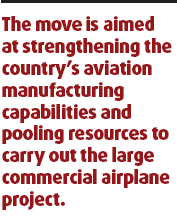AVIC I and AVIC II to be restructured
Updated: 2008-01-03 09:12
The businesses of AVIC I and AVIC II, the country's two leading State-owned aviation manufacturers, are likely to be restructured and consolidated to realize the country's ambitious plan of developing a homegrown large commercial aircraft.
"A possible plan is to consolidate commercial aircraft manufacturing businesses of the two enterprises and establish a new firm, which will become a shareholder in a company taking charge of assembling the large airplane," an official with China Aviation Industry Corp II (AVIC II) told China Daily yesterday.
The State Commission of Science, Technology and Industry for National Defense is working on the restructuring plan, which will await approval from the State Council and the National People's Congress, the official said.
A source with AVIC I yesterday confirmed this and said the country's ambitious plan to develop its own large commercial airplanes is the major driving force behind the consolidation move.
"Details of the consolidation will likely be announced in March," said the source, who also declined to be named.
Liang Zhenhe, vice-president of AVIC II, told China Daily in mid-December that a company responsible for the large airplane project would be established by March. Shareholders of the firm are likely to include AVIC I, AVIC II, State-owned investment companies and Chinese airlines. The aircraft will be assembled in Shanghai, with the nose, fuselage and tail sections manufactured in other provinces.
"The new joint venture company would be responsible for assembling the large aircraft, with the components manufactured in existing companies controlled by AVIC I and AVIC II," the AVIC II official said yesterday.
AVIC I and AVIC II are two large State-owned industrial groups reporting directly to the central government.
AVIC I manufactures the ARJ 21, China's indigenously developed regional jet with 70-100 seats, and the 50-seater turboprop MA60. AVIC II is the country's only manufacturer of military and commercial helicopters. It also manufactures the 50-seater ERJ 145 regional jet in partnership with Brazilian plane maker Embraer.
Both companies have been supplying components to Boeing and Airbus. They are also involved in making non-aviation products such as automobile components and motorcycles.

The two companies were born in 1999 in an industry overhaul that split the former China Aviation Industry Corp into the two main blocs.
"At a time when China is trying to realize the dream of making its own large aircraft, pooling the existing civil aviation manufacturing resources of AVIC I and AVIC II is a reasonable choice," said Wu Yucun, an aviation analyst with Shenzhen-based Lianhe Securities.
"But the main purpose of the splitting eight years ago was to create competition in the industry. It is hard to say now whether consolidation would necessarily result in improved business," Wu said.
Wu's views were echoed by Liu Weimin, a senior analyst with the Civil Aviation Management Institute of China. "Improved management would be a prerequisite for the success of the consolidation," Liu said.
China plans to produce a homegrown passenger jet with at least 150 seats to challenge the domination of Boeing and Airbus in the country's fast-growing aviation market.
The State Council, the Cabinet, approved the project in February 2007 and the aircraft is expected to take off by 2020. The government has put the project in its 11th Five-Year Plan (2006-10), along with moon exploration and manned spaceflight.
|
|



